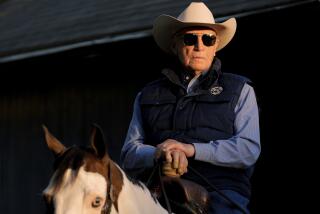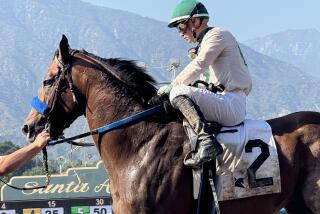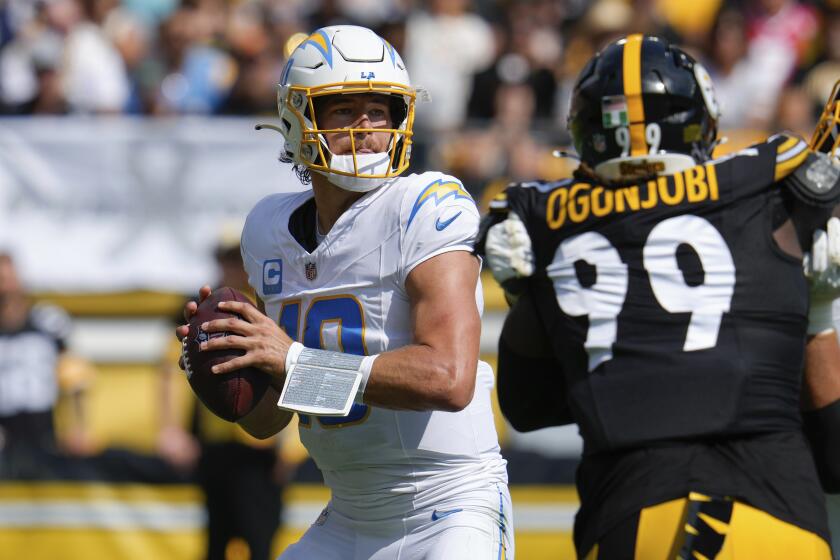Big Cap tips its hat to Seabiscuit on 75th anniversary of stirring win
Seventy-five years ago when they ran the Santa Anita Handicap the attendance was 68,525, plus George O’Bryan. It is fair to say that all 68,526 had come to watch Seabiscuit run.
It was 1940. There were still remnants of the Great Depression. There was a war, little money and no freeways, but they still came. Now, it is likely that fewer than a handful of people who were there that day are still with us.
“It’d be hard to get a good card game out of us,” O’Bryan has joked to his son, Craig, a whippersnapper of 65, who, like his father was, is among the top jockey agents in the sport.
Among George O’Bryan’s riders were Hall of Famers Ralph Neves, Manny Ycaza, Don Pierce and Laffit Pincay Jr. Among Craig’s riders is Hall of Famer Gary Stevens. Oh, yes, and George’s grandson and Craig’s son, 27-year-old Brandon, is also a jockey’s agent with a Hall of Fame client, Alex Solis.
So when you sit down with George O’Bryan in the Arcadia Gardens Retirement Hotel, you are in legendary company. Five of O’Bryan’s jockeys won Santa Anita Handicaps, including Pincay on Affirmed and John Henry.
It also helps that, at 94, the man known for years as “Black Heart” for his ability to get his riders on great horses and disappoint others in the process, O’Bryan still has his memory fast ball.
“The 1940 race was a beautiful day, probably 70 degrees,” O’Bryan said, “and I watched it from center field [the track infield]. They’d just opened up the tunnel at Santa Anita, and going out there to watch was kind of a novelty.”
The hearing aid was turned up, the nearby TV provided perfect background atmosphere with the channel tuned to horse racing, and the glimpses of 75 years ago, and the great horse that made the ’40 Big Cap a day of history came rushing back.
“I caught a look at Seabiscuit when they turned for home, and I had a clear view of him the rest of the way,” said O’Bryan, who was 19 at the time and an exercise rider. “He got by on the rail and that was it. He probably won by two lengths.”
The official chart says it was one length. The grainy old film on YouTube makes the finish look closer to O’Bryan’s memory than the chart.
“Seabiscuit was a little crooked in the front, you know,” O’Bryan said. “He wasn’t a pretty horse.”
Indeed, that was part of Seabiscuit’s every-man quality that seemed to appeal to the masses the most.
“In those days, my dad told me,” Craig O’Bryan said, “the headlines were either about war or Seabiscuit.”
In addition to not being all that pretty, Seabiscuit wasn’t all that big, either. Also, he was a bit injury prone and didn’t always have the best luck in the biggest races.
That made the 1940 Big Cap about elements that forever inspire the human spirit: underdogs and comebacks.
When Seabiscuit won the race, the last one he would run, he became the winningest thoroughbred in history in terms of money, $437,730. But coming in, he had suffered through a serious injury that kept him out of the race in 1939. He had lost both the 1937 and 1938 Big Caps.
Plus, he was now a 7-year-old, and few thoroughbreds that long of tooth, then and now, win big races. So the country, with no competing collection of alphabet soup pro leagues (NFL, NBA, NHL, etc.) showered its affection on this crooked horse who could really run.
“Those were the days,” George O’Bryan said. “People dressed up for the races. Men wore hats. Women wore hats.
“When Seabiscuit went to the winners’ circle, it was jammed with people. Everybody wanted to see the great horse.”
With greatness, almost inevitably, comes controversy.
There are those who say that Seabiscuit won that day in 1940 because his closest challenger, second-place finisher and defending champion Kayak II, was held back at the end. Charles Howard owned both horses. In those days, that meant they were coupled for betting purposes and the owner could legally declare one horse to win and the other to be held back in a close finish.
“I remember hearing that Howard walked out into the stands and told people he had declared Seabiscuit to win,” George O’Bryan said.
In a 2003 story in The Times by Bill Christine, relatives of two now-deceased jockeys in the race were quoted. One said Johnny Adams was supposed to ride Kayak II and didn’t because he was told to hold back at the end. The other said that Leon Haas, who did ride Kayak II, followed Howard’s orders and did just that.
O’Bryan said it didn’t matter.
“Seabiscuit would have won, anyway,” he said.
Seabiscuit died in 1947 at 14 and was buried at Howard’s Ridgewood Ranch in Willits, Calif., where he rests today, though exactly where on the ranch remains the subject of some controversy.
The property is now owned by the Church of the Golden Rule and several people have been quoted in recent years as saying that, with new structures and new development on the land, Seabiscuit’s bones rest under a paved parking lot.
“He should be buried at Santa Anita,” O’Bryan said, “right there under his statue in the paddock.”
Some members of the extended Charles Howard family will be at Santa Anita Saturday for the 78th running of the now $1-million race. They will be part of the celebration of Seabiscuit’s memory.
Favored Shared Belief will share the stage with the spirit of Seabiscuit.
Craig O’Bryan will also have a runner, with Stevens on Catch a Flight.
And George O’Bryan will be just fine, watching on TV a mile away in his retirement hotel.
No need to fight the crowds. After all, he’s been there, done that, and Shared Belief, as good as he is, is no Seabiscuit.
Follow Bill Dwyre on Twitter @DwyreLATimes
More to Read
Go beyond the scoreboard
Get the latest on L.A.'s teams in the daily Sports Report newsletter.
You may occasionally receive promotional content from the Los Angeles Times.











